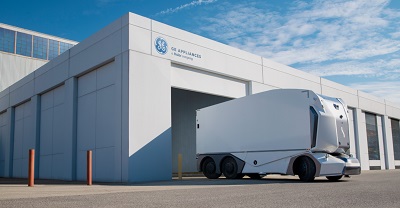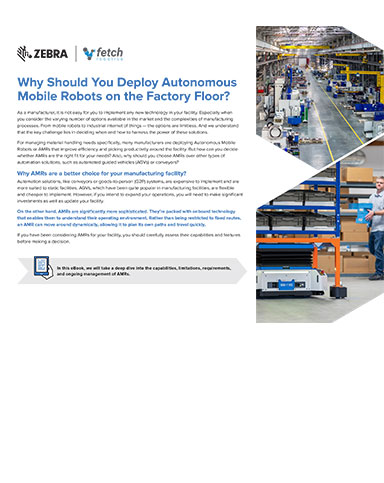Autonomous vehicles from Einride are coming to GE Appliances
Autonomous and electric trucks will streamline the appliance maker's operations.
If you get the chance to visit GE Appliance’s famed Appliance Park in Louisville, you might also get a chance to see the starts of a logistics revolution. Instead of tractor trailers, a small fleet of pods from Einride, a Swedish freight technology company, are shuttling trailer-load quantities of material between the five manufacturing and assembly facilities on the campus. They are aerodynamic and futuristic not to mention all electric and autonomous. No operator is behind the wheel – in fact, there’s no wheel. You can click here to watch a YouTube video of the pods in action.
The pods are one of two projects that GE Appliance, a Haier company, is doing with Einride. In the other, the appliance manufacturer is using all-electric drayage trucks from Einride in Georgia, Tennessee and Kentucky, with a goal of saving 970 tons of CO2 emissions within the first year. The electric vehicles are not autonomous. The deployments are part of a billion-dollar investment commitment by GEA in its U.S. manufacturing and distribution operations.
According to Harry Chase, the director of advanced materials, the projects are a small segment of innovation initiatives at GE Appliances – there are more than 100 currently underway. Chase’s job is to introduce new technology to streamline operations, reduce GE Appliance’s carbon footprint and minimize supply chain disruptions. “I get to look at shipping from the supplier to lineside delivery, including the material flow inside the plants,” he says.
Among the projects his team has launched is the deployment of IoT sensors throughout the supply chain to get better data about the movement of goods from those suppliers to the line. For instance, GPS Bluetooth sensors are tracking the movement of material from Mexico to the U.S., where the shipments are then picked up by the platform from Four Kites used by GEA. Other sensors are tracking ocean shipments, with plans to add rail and domestic transportation in the future. Those don’t include a variety of robotic, automation and data collection projects inside the plants and warehouses. “We are challenged to improve our supply chain as a whole,” he says. “So, my team has a budget to test and experiment with different technologies that might make us better and more interconnected and get us closer to the customer.” They might not always have an ROI, “but we feel that in the long run, they’ll give us a competitive advantage. That’s our philosophy.”
While Chase has been working inside the facilities for years, it’s only been in the last 7 or 8 years that reliable technology has become available outside the four walls. Enter the two projects with Einride. The European freight tech company may not be a household name in the U.S., where several domestic companies are working on autonomous and electric trucks. What sold Chase on Einride’s technology was the company’s approach to the design of the vehicles. “A lot of the providers we looked at are taking existing tractor trailers and making them autonomous, or electric,” Chase says. “Einride asked: What would we build if we started from scratch and made it modular?” As an example, since the autonomous vehicle doesn’t require an operator in the cab, there was no point in building a traditional cab. “Since it’s all autonomous, you just need the storage area and the power to drive the pod,” Chase says. “The whole thought process is innovative.”
The electric vehicles do require drivers, and drivers are always the variable when it comes to energy savings. The software behind the electric trucks tracks the CO2 savings, and has logic that advises the driver on how to operate the vehicle based on the location of charging stations.
Of the two projects, the electric vehicles are easier to understand. They are a component of GEA’s sustainability strategy. There are 6 vehicles to start, and they’ll be deployed in Georgia, Kentucky and Tennessee for milk runs of up to 90 miles round trip. Those include drayage from the port to a logistics center in Georgia and from the logistics center to a manufacturing plant; and from logistics centers to plants in Kentucky and Tennessee. GEA is building out the infrastructure to charge the vehicles. “If we only throw 10,000 lbs on a truck, we can run all day and then charge at night,” Chase says. They will deploy opportunity charging if running heavier loads of up to 40,000 lbs.
In addition to sustainability goals, the trucks will reduce maintenance costs because electric vehicles have fewer moving parts. That’s important in some regions where trained diesel mechanics are in short supply.
The autonomous vehicle project is more complex. “We’ve been looking for years to find ways to move materials, like injection molded agitators, between the 5 support and manufacturing plants on campus more effectively,” says Chase. “We looked at a number of solutions, including outdoor tuggers, but it’s difficult to unload them, and weather can create problems.” The pods, on the other hand, can be loaded and unloaded at the dock with a lift truck, like a traditional trailer.
The pods navigate by a combination of GPS and LIDAR. GPS tracks the location, while four 3D LIDAR sensors map the operating environment. Tied together, the system knows its position and also understands the obstacles and landmarks on the routes.
After a successful pilot using lift trucks for loading and unloading, GEA went back to Einride with a list of changes, such as adapting the equipment for American docks versus European docks. For example, the standard ICC bar blocks some of the LIDAR. The goal is to have the vehicles ready for operation in the 3rd or 4th quarter of 2022.
To start, they will not be fully autonomous. GEA is using a remote driving station with an operator who can monitor the vehicles. For instance, if there is an obstacle in the road, the remote pilot can decide whether to take over the controls or let the vehicle continue to navigate autonomously. To start, one pilot will monitor 3 vehicles with a goal of having one pilot monitor up to 9 vehicles. “Right now, we’re about 60% autonomous and 40% monitored, and our goal is to get to 95% full automation,” Chase says.
Autonomous trucks are just one piece of a bigger picture for material flow on the campus. Ultimately, GEA wants to automate the entire end-to-end process, starting with a robot to load finished parts onto a carrier that will be transported to a shipping dock by an autonomous mobile robot. At shipping, the carrier will be transferred onto a conveyor that will dock with a conveyor inside the pod for automatic loading and unloading. When the pod arrives at a manufacturing plant, the carriers will be automatically unloaded onto conveyor at receiving, inducted onto an autonomous mobile robot and then automatically delivered to the assembly line on a just-in-time basis.
“We want to have one seamless, synchronized material flow where no one touches it,” Chase says. That is proving more difficult to achieve, at least for now. “Our biggest challenge is getting robots to talk to robots, and it’s been interesting,” says Chase.
Chase believes that projects like these are essential to GEA’s success in the future. “While we’re investing in automation, we’re still adding to our headcount,” he says. “So, we have to look at how we support the worker by eliminating the dirty, dull and difficult jobs while building out the infrastructure that will allow us to be flexible and get closer to the customer.”
And, by working with innovative companies “we can influence how that technology flows in the future.”













